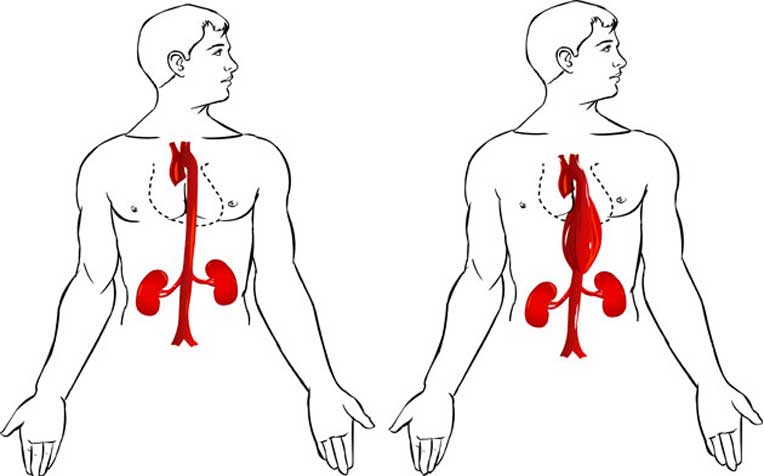
An aortic aneurysm , a balloon-like swelling in the aorta, is now treatable with minimally-invasive surgery called endovascular aortic repair.
An
aortic aneurysm is an abnormal, balloon-like swelling in the aorta, the body’s largest artery. The aorta runs from the heart to the abdomen and down to supply blood to the legs.
A large, fast-growing aortic aneurysm may rupture and cause massive bleeding into the chest or the abdomen. This bleeding can send the body into severe shock which can be fatal.
An aortic aneurysm usually occurs in the middle-aged and elderly (aged 50 and above). Smokers too, bear a significantly higher risk. Screening for abdominal aortic aneurysms is recommended for current or past male smokers over the age of 65.
Aortic aneurysm: How to prevent
The best way to prevent or to slow the growth of aortic aneurysms is by leading a healthy lifestyle, such as engaging in the following healthy activities:
Keep your blood pressure and cholesterol levels under control
Eat a healthy diet
Exercise regularly. Complete at least 150 minutes of moderate intensity exercise a week.
Quit smoking (if you are a smoker)
Causes of an aortic aneurysm
The exact cause is unknown but normal ageing and chronic health conditions can lead to a weakening of the aortic wall, which can then bulge under the pressure of blood flowing through the aorta. These chronic conditions include:
Coronary atherosclerosis (hardening of the coronary arteries) due to diabetes, high blood cholesterol or lipids, chronic smoking
Infection or inflammation in the aorta
High blood pressure (hypertension)
Congenital conditions such as Marfan syndrome (a connective tissue disorder) and bicuspid aortic valves
Types of aortic aneurysm
There are mainly two types of aortic aneurysm:
Abdominal aortic aneurysm: Occurs in the abdomen along the part of the aorta, which passes through the abdomen.
Thoracic aortic aneurysm: Occurs in the chest along the part of the aorta, which passes through the chest cavity.
Symptoms of an aortic aneurysm
An aortic aneurysm is usually asymptomatic as an aneurysm may grow gradually over the years. However, at a later stage, symptoms appear depending on the location of the aneurysm.
For abdominal aortic aneurysm
Deep, constant abdominal pain
Pulsations in the abdomen
Throbbing lump in the groin or legs
Lower back pain
For thoracic (chest) aortic aneurysm
Deep, throbbing chest pain
Difficulty swallowing
Shortness of breath
Cough and hoarseness
Aortic aneurysm: How to diagnose
An aortic aneurysm can be diagnosed with the help of an ultrasound, computed tomography scan (CT scan) or magnetic resonance imaging scan (MRI scan) of the chest or abdomen.
If it’s large enough, an aortic aneurysm in the abdomen can be detected by clinical examination. These investigations are also used to monitor the size of the aneurysm over time to assess the risk of rupture and the timing of surgery.
Traditional open surgery to treat the aortic aneurysm before it ruptures is associated with significant risks of morbidity and death. It is also not suitable for high-risk patients with diabetes and heart conditions – as it is simply too risky.
Endovascular aortic repair: Minimally invasive surgery for aortic aneurysm
“About 30 to 40 per cent of patients seeking treatment for aortic aneurysm are not suitable for open surgery due to the high cardiac risks involved,” say doctors from the Department of General Surgery at Singapore General Hospital (SGH), a member of the SingHealth group.
In the past, these patients faced a possibility of death should the aortic aneurysm rupture suddenly. Fortunately, with a newer, safer and minimally invasive surgical technique called endovascular aortic repair, chances of repairing the aneurysm are good.
Endovascular aortic repair, also called endovascular stent grafting, is ideal for large aortic aneurysms. It is also suitable for elderly patients with chronic medical conditions such as diabetes, high blood pressure and coronary heart disease.
Endovascular aortic repair vs open surgery
Unlike traditional open surgery, in which a surgeon has to cut open the chest or abdomen, locate the aneurysm, place clamps and clean up the site before inserting a fabric graft, endovascular surgery is a fairly simple procedure. It only requires a small surgical cut near the groin.
Using a series of tiny wires and catheters, a covered stent graft is threaded towards the swollen aorta.
The stent graft is then positioned under X-ray guidance and released so that it expands inside the blood vessel. This relieves pressure on the aneurysm and reduces the risk of it bursting. There is no need for long incisions on the chest or abdomen or cross clamps on the aorta.
Benefits of endovascular aortic repair
Endovascular aortic repair is a safer option for patients because it has a lower risk of surgical complications and has a much reduced risk of mortality compared to open repair.
“Endovascular surgery is performed under local anaesthesia or light sedation. This means patients remain fully alert but do not feel any pain during surgery. General anaesthesia is not needed which reduces the risk of surgical complications such as a stroke or heart attack,” say doctors from the Department of General Surgery at SGH.
Other benefits of endovascular aortic repair over open surgery include:
Shorter hospital stay (two to three days instead of 7 to 10 days)
Shorter recovery period (two weeks instead of four weeks)
Lower operative mortality rates
Less post-operative pain
Less blood loss and less scarring
Endovascular aortic repair can also be used in cases that may not be suitable for open repair, such as complex aneurysms
Like any operation, endovascular surgery does carry some risks such as “endoleaks” (blood leaking out of and around the stent graft) and kidney failure. Possible migration or blockage of the stent graft can be remedied.
To lower the risk of developing aortic aneurysm, eat a healthy diet and keep chronic medical conditions under control.
Ref: I23 (ed)
Check out these related articles:
Marfan Syndrome: What Is It and How to Manage















 Get it on Google Play
Get it on Google Play